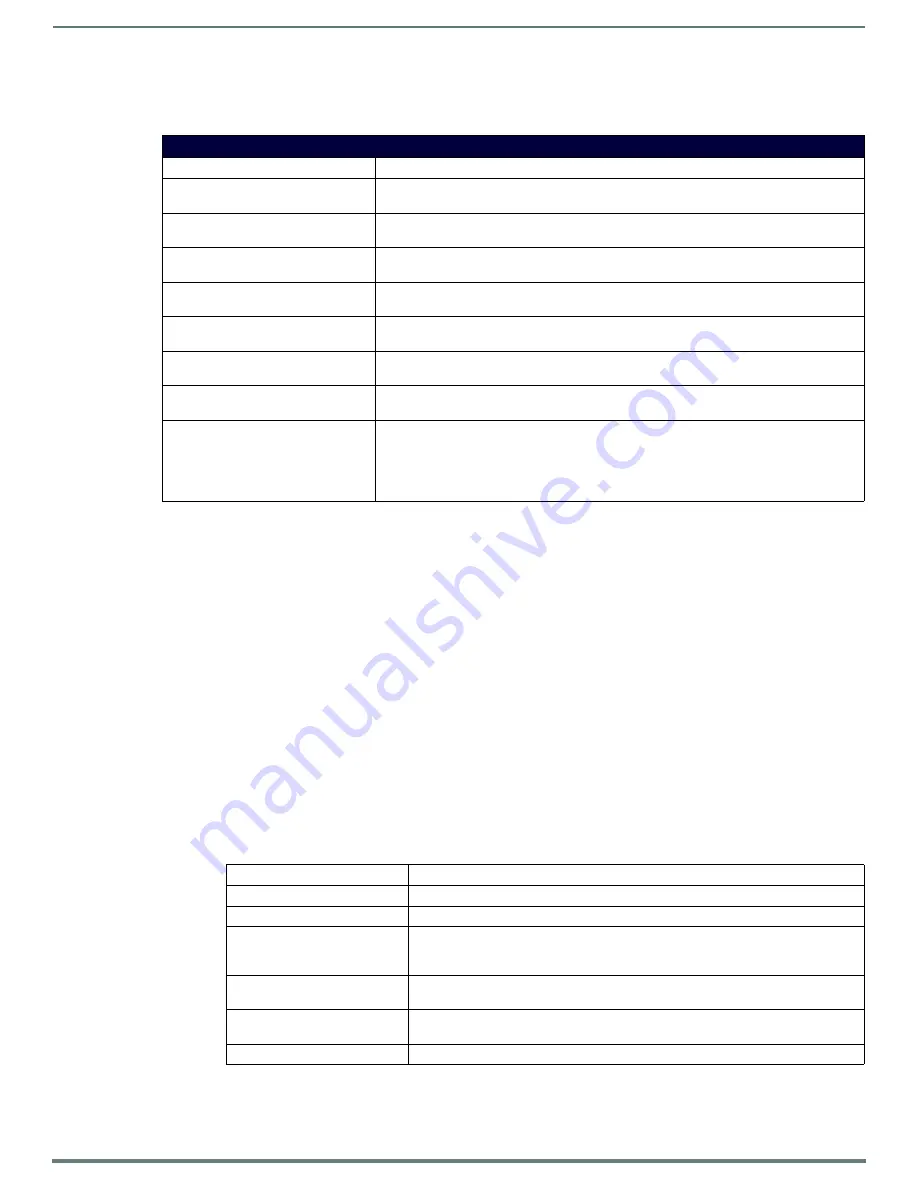
Terminal (Program Port/Telnet) Commands
105
NetLinx Integrated Controllers (Firmware v4)- WebConsole & Programming Guide
Access Rights Menu
The Access Rights Menu is accessed whenever you select
Change Access Rights
(option
6
) from the Edit User menu, or
Change
Access Rights
from the Edit Group menu. The options in this menu is described below:
Adding a Group
1.
Type
7
and
<Enter>
at the Security Setup prompt (at the bottom of the Main Security Menu) to add a group account. A sample
session response is:
The following groups are currently enrolled:
administrator
Enter name of new group:
2.
Enter a name for the group. A group name is a valid character string (4 - 20 alpha-numeric characters) defining the group.
This string is
case sensitive
, and each group name must be unique.
3.
Press <Enter> to display the Edit Group menu.
Edit Group Menu: Add Directory Association
1.
At the
Edit Group
prompt, type
1
to add a new directory association.
A
Directory Association
is a path that defines the directories and/or files that a particular user or group can access via the
HTTP (Web) Server on the NetLinx Master. This character string can range from 1 to 128 alpha-numeric characters. This string
is
case sensitive
. This is the path to the file or directory you want to grant access. Access is limited to the user (i.e. doc:user)
directory of the Master. All subdirectories of the user directory can be granted access.
A single '/' is sufficient to grant access to all files and directories in the user directory and it's sub-directory.
The '*' wildcard can also be added to enable access to all files.
All entries should start with a '/'.
Here are some examples of valid entries:
By default, all accounts that enable HTTP Access are given a '
/*
' Directory Association if no other Directory Association has
been assigned to the account. When you are prompted to enter the path for a Directory Association, the NetLinx Master will
attempt to validate the path.
Access Rights Menu
Command
Description
1) Terminal (RS232) Access
(Enable/Disable)
Enables/disables Terminal (RS232 Program port) Access. The account has sufficient access
rights to login to a Terminal session if this option is enabled.
2) Admin Change Password Access
(Enable/Disable)
Enables/disables Administrator Change Password Access. The account has sufficient access
rights to change the administrator password if this option is enabled.
3) FTP Access
(Enable/Disable)
Enables/disables FTP Access. The account has sufficient access rights to access the NetLinx
Master's FTP Server if this option is enabled.
4) HTTP Access
(Enable/Disable)
This selection enables/disables HTTP (Web Server) Access. The account has sufficient access
rights to browse to the NetLinx Master with a Web Browser if this option is enabled.
5) Telnet Access
(Enable/Disable)
This selection enables/disables Telnet Access. The account has sufficient access rights to login
to a Telnet session if this option is enabled.
6) Configuration Access
(Enable/Disable)
This selection enables/disables Configuration Access rights for the target Master. The account
has sufficient access rights to access the Main Security Menu if this option is enabled.
5) ICSP Security
(Enabled/Disabled)
This selection enables/disables ICSP communication access. The account has sufficient access
rights to initiate ICSP data communication.
6) ICSP Encryption Required
(Enabled/Disabled)
This selection enables/disables the need to require encryption of the ICSP communicated data.
If enabled:
• All communicating AMX components must authenticate with a valid username and password
before beginning communication with the Master.
• All communication must be encrypted.
Path
Notes
/
Enables access to the user directory and all files and subdirectories in the user directory.
/*
Enables access to the user directory and all files and subdirectories in the user directory.
/user1
If
user1
is a file in the user directory, only the file is granted access. If
user1
is a
subdirectory of the user directory, all files in the
user1
and its sub-directories are
granted access.
/user1/
user1
is a subdirectory of the user directory. All files in the
user1
and its sub-
directories are granted access.
/Room1/iWeb ControlPages/*
/Room1/iWeb ControlPages
is a subdirectory and all files and its subdirectories are
granted access.
/results.txt
results.txt
is a file in the user directory and access is granted to that file.


























